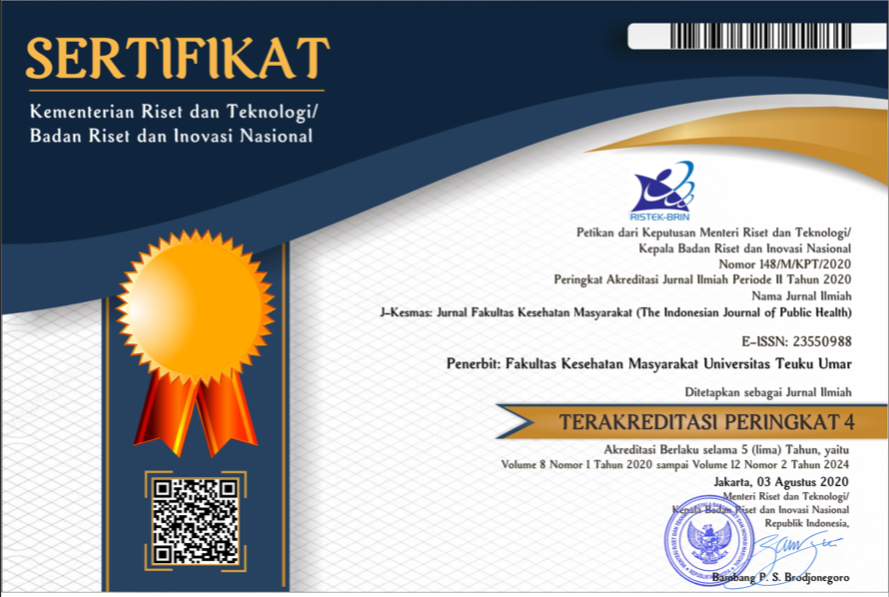Relationship Between Online Food Ordering Time and Physical Activity With The Nutritional Status of Students at Medan Area University
Abstract
The emergence of online food ordering applications. Currently, it is widely used by various groups of people including students. With the online food ordering application, it provides convenience in mobilization and in ordering food. The negative impact of using online applications is that there will be reduced physical activity used to buy food. Low physical activity will have an impact on increasing the risk of non-communicable disease incidence. Excessive eating patterns, carried out at inappropriate times (night) and lack of physical activity can cause poor metabolism so that it will cause more nutrition. The type of research used is descriptive research, with a cross-sectional research design, using the survey method. The population is students of the faculty of economics at Medan Area University. The sampling technique used is nonprobability sampling with incidental sampling technique, which is a sampling technique based on chance, that is, anyone who by chance or incidentally meets the researcher can be used as a sample, if it is seen that the person who happened to be met is suitable as a data source. The number of samples in this study were 100 respondents. Based on the results of the analysis using the Chi-Square test, it is known that research on the relationship between online food ordering time and physical activity with nutritional status explains that the value of p = 0.004 (physical activity) and p = 0.006 (online ordering time).
Full Text:
PDFReferences
Agustian H, Eka Putra A, Hendsun H, Chandra H, Firmansyah Y, Chandra Sumampouw H, Firmansyah Y. 2021. An overview of student physical activity during distance learning and the COVID - 19 pandemic. J Med Hutama, 2(1):726-732.
Agustina RK. 2013. Analysis of factors that influence the consumption patterns of boarding students in Makassar City [thesis]. Makasar: FEB UIN.Anonymous. Accessed 2020. Mims Indonesia. Ethyl Chloride.
Bandín C, Scheer FA, Luque AJ, Ávila-Gandía V, Zamora S, Madrid JA, Gómez-Abellán P, Garaulet M. Meal timing affects glucose tolerance, substrate oxidation and circadianrelated variables: A randomized, crossover trial. Int J Obes (Lond). 2015;39(5):828-33. https://doi.org/10.1038/ijo.2014.182.
[Department of Health of the Republic of Indonesia. 2014. Regulation of the Minister of Health of the Republic of Indonesia Number 5. Jakarta: Indonesian Ministry of Health.
Lundgren, D. J., 2013. The Prevalence of Night Eating Syndrome and Binge Eating Disorder Among Overweight and Obese Individuals. HHS Public Access, pp. 233-236.
Nursilmi, Kusharto CM, Dwiriani CM. 2017. Relationship between nutrition and health status with quality. MKMI, 13(4):369-379. https:// doi.org/10.30597/mkmi.v13i4.3159
Parastika, T. D., 2012. Overview of Factors Associated with Night Eating Syndrome in Students of the Faculty of Engineering, University of Indonesia, Depok: s.n.
Rahayu, T.B., 2020. Analysis of Factors Affecting the Nutritional Status of Adolescent Girls. J. Vocational Health. 6, 46.https://doi.org/10.30602/jvk.v6i1.158
Nuraliyah, Syam, Aminuddin & Hendrayati. (2013). Physical Activity and Sleep Duration in Overweight and Obese Students of Hassanudin University. Nutrition Science Study Program, Faculty of Public Health. Hasanudin University.
Hasdianah, HR, (2014). Nutrition, Nutrition Utilization, Diet, and Obesity. Yogyakarta: Nuha Medika.
DOI: https://doi.org/10.35308/j-kesmas.v10i1.7804
Refbacks
- There are currently no refbacks.
Managed by Fakultas Kesehatan Masyarakat
Published by Universitas Teuku Umar
Website: http://jurnal.utu.ac.id/jkesmas
Email: jkemas@utu.ac.id 
This work is licensed under a Creative Commons Attribution-ShareAlike 4.0 International License.







.jpg)


